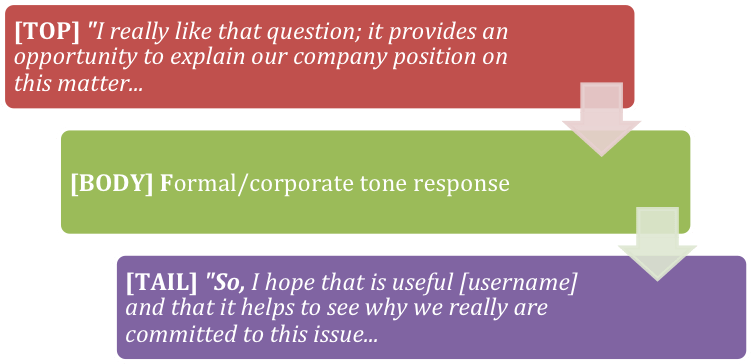In this article, the fifth in a series of ‘how-to’ guides for the pharmaceutical industry, Paul Grant looks at the way in which sometimes indeterminate ‘tone of voice’ can portray something about the personality of your company.
In our last ‘how-to’ we introduced some ideas for pre-approving content to be used in social media engagement.
One of the challenges in pre-approving content is that a piece of text can oftentimes be reviewed and approved by many people – to the extent that the original message intent can become very ‘stale’, ‘non-human’ or ‘corporate’ in tone.
Whilst it may remain technically correct, the text may no longer connect with the audience on an emotional or personal level.
Typically, a person has a relationship with someone else because of a connection between his or her personalities or interests. In some cases, individuals also develop a longer-term allegiance or brand-loyalty to a company – which in certain contexts may be considered a ‘person’ too. The most effective companies understand this and develop an engagement strategy where there is a consistent and defined personality for people to connect with. Consider household names such as Red Bull, or Apple, or Virgin Atlantic – each has a distinguishable set of principles and content approach that resonates with their particular type of customer.
Tone of voice
‘Tone of voice’ describes perceived personality detectable in written text, possibly containing elements such as humour, formality, warmth or other human-recognisable traits. It is not what you say, but how you say it.
“It is not what you say, but how you say it.”
People may behave differently online to how they do in person
. For example, their conversational tone may be ‘bolder’ and more ‘heightened’ than perhaps in a face-to-face setting. Consequently, user-generated text may appear ‘blunt’ when sent via email, message board, SMS or some other text based channel.
As was introduced in our previous article in this series, some comments that may ordinarily be accompanied by ‘body language’ do not translate well when only created as text. This can lead to misinterpretation, confusion, and potential escalation of emotion, which may not be a reflection of the intent or conversation topic itself.
When a corporate function of a company creates content, the content is often written as if for a press release. This is a particular tone of voice – which may work well for press releases but doesn’t translate to online conversation.
To avoid this, pre-approved answers for online conversation should ideally be ‘humanised’ and put into first-person narrative rather than in a ‘corporate’ tone of voice.
This can benefit the community and build a sense of credibility, relationship and trust; especially if executed well.
An even better scenario is where approved representatives are empowered to respond in real-time, in a natural way, perhaps paraphrasing pre-approved company position statements. Corporate communications colleagues or medical information colleagues are usually already empowered to represent the company in this way. In many cases they may also be able to do this in social media channels – subject to appropriate training.
Sometimes it is simply not possible to convey an important health point or response without also creating an official positioning statement. Let’s now look at some tools that can help to ‘humanize’ corporate content.
Top and Tail
Where pre-approved content must be used in an agreed format, it can be useful to also pre-approve or permit non-approved ‘top and tail’ content which wraps the formal response in a more human way. [See Figure 1]

Figure 1 – ‘Top and Tail’ approach to wrapping formal responses
Mix and Match
If there is only a limited number of responses that can be approved in time for an engagement initiative – perhaps due to legal and medical resource or other pressures, it can be useful to set these up using a ‘Mix and Match’ format in a spreadsheet or database solution, so that variations can be quickly created that give variety in the conversation, yet are actually entirely pre-approved.
The approach requires a segmentation of content [See Figure 2] to increase the permutations and combinations of responses. Each message may be assembled using ‘drop-down’ fields in a tool such as Microsoft Excel for:
- A piece of factual or interesting information (which may be a statistic, a piece of medical information, or a campaign message) – it is vital that no more than one of these items is in the message, so that it is not possible to create non-compliant responses (i.e. two pieces of medical information which might imply a fact which is not true)
- A call to action (which may be ‘Read more here’ or ‘Visit our page’)
- A link
- A ‘hashtag’ or other grouping identifier (if required)
| AWARENESS RAISING | Did you know some online meds are counterfeit? |
| CALLS TO ACTION | Find out more http://on.fb.me/link |
| HASHTAG 1 | #counterfeit |
| HASHTAG 2 | #meds |
| FULL MESSAGE | Did you know some online meds are counterfeit? Get wise here. Find out more http://on.fb.me/link #counterfeit #meds |
| CHARACTER COUNT | 115 |
Figure 2 – A ‘Message Maker’ for creating variations on preapproved content
With tools such as these, it is possible for a pharmaceutical company to convey accurate and approved information in a more ‘human’ tone of voice.
Photo credit: Thomas Hawk / Foter / CC BY-NC


